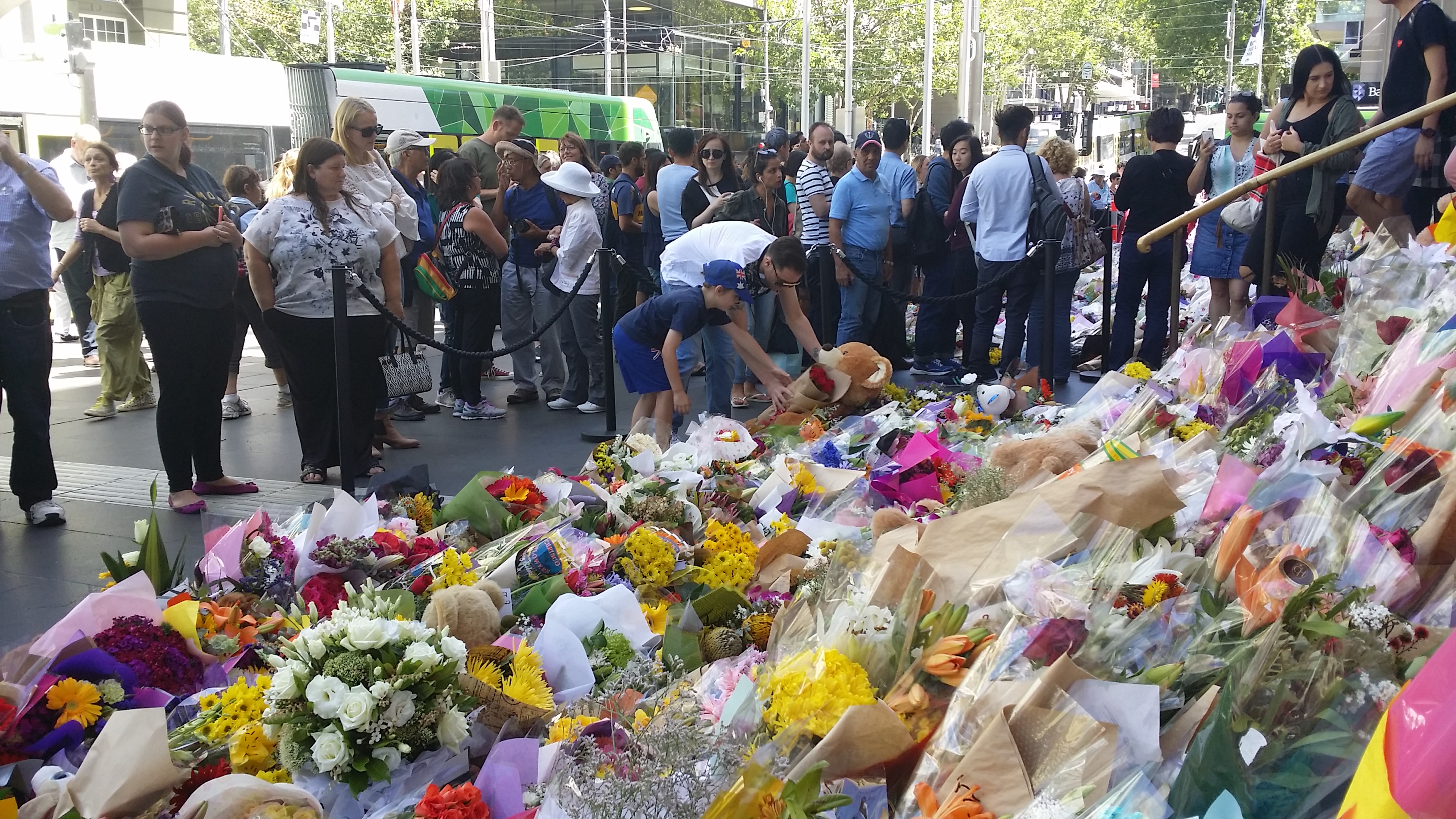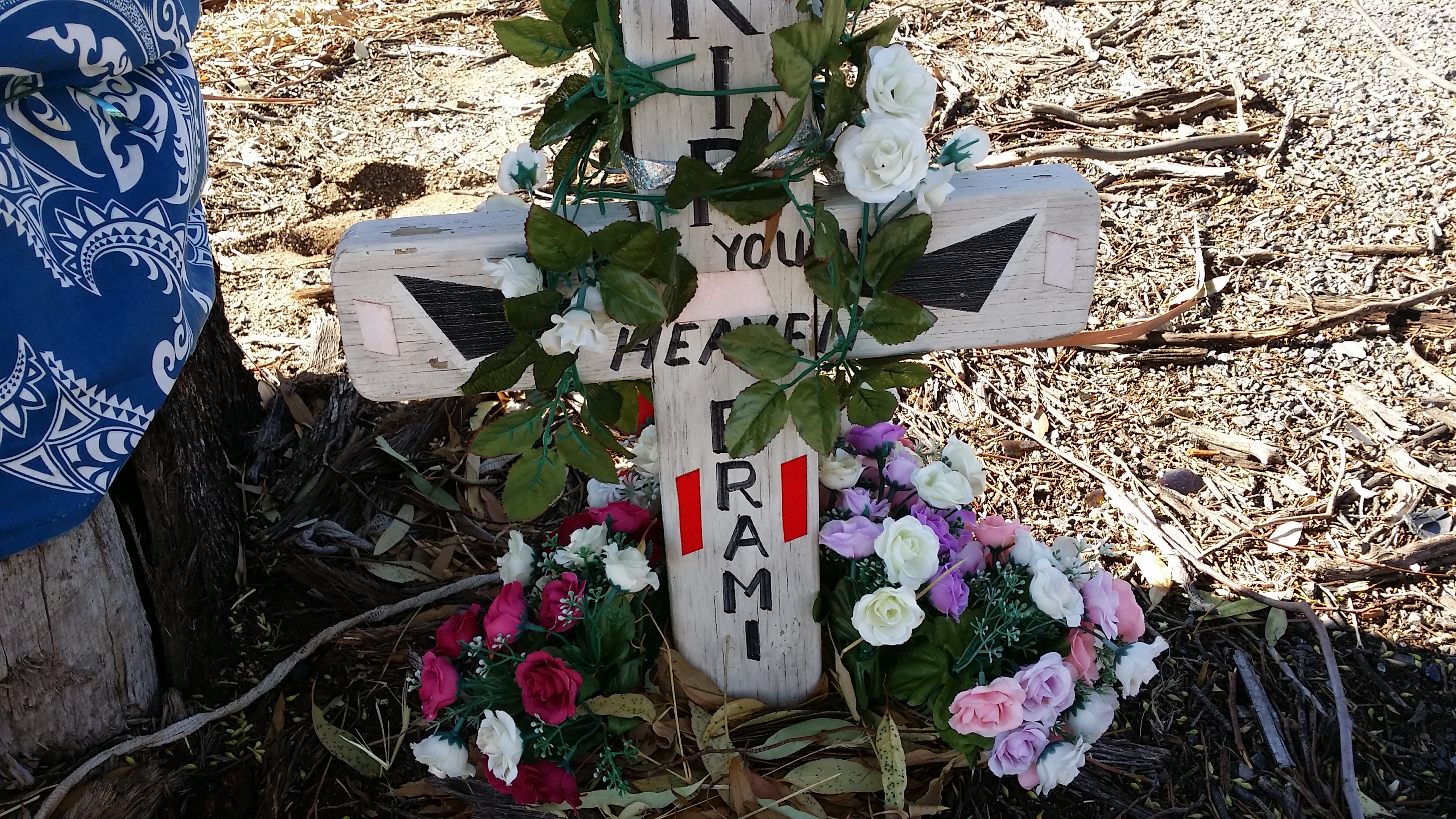It is now a global phenomena that people respond to tragedy and loss of life with the sharing of public flower tributes. There is a huge outpouring of grief that follows tragic and unfathomable events, be they international terrorism, local criminal activity or natural disasters.
Everyone brings their own grief, expressed in the flowers and cards they bring or come to view. These spontaneous memorials offers a public place for all to acknowledge their grief for those injured or killed. They allow for the longing that more lives could have been saved, that the event could have been prevented. They allow for private contemplation and mourning in the company of others and allow for healing to begin.

As each new tragedy unfolds, I view these flower memorials through the lens of my own grief and that of a landscape management professional. I remind myself that the site must be managed; the flowers removed sometime soon. How should we respond to this public memorialising of grief? What do these mass flower tributes mean and how should we manage them?
In Australia trees, gardens and flowers have long been used to ‘sanctify the site’ of loss, as noted in ‘‘Reading the garden, the settlement of Australia’ (2008). This book reminds us that:
‘Like avenues of honour, roadside memorials and mass flower tributes make private mourning public. Transforming secular sites into sacred ones by the use of various symbols, including flowers’.
Temporary public flower tributes also allow grief to be expressed after immediate outbursts of anger following tragic public events. This anger is often directed at public offices such as the government, parole board, the courts, the mental health system, police and emergency services. In time the coroner will investigate the events and processes surrounding the tragedies, but in the immediate aftermath, with little information available, anger is common.
Many different kinds of people are affected by tragic events apart from the families of the deceased. These include visitors, workers, witnesses, first responders, police and emergency services. Temporary flower tributes can be distressing for those working in the area every day. The flowers must not be allowed to stay too long. These sites must be managed so that their removal is managed sensitively and respectfully.
Managing public flower memorials
The death of Princess Diana in 1997 led to the first large public display of grief through flowers. An estimated 10,000-15,000 tonnes of flowers were left at various sites. Eleven days after Diana’s death the cleanup started, taking many weeks.
After the Lindt Café siege in Sydney, in 2014, the estimated 100,000 bunches of flowers brought to Martin Place were removed a week later. Written tributes and cards were separated for the families of the deceased. Volunteers from the State emergency service and Red Cross were used to collect, sort and remove the flowers.
After the Bourke Street tragedy in 2017, the flowers were removed 11 days later. A collection ceremony was conducted. Removal of the flowers was called the next stage in the city’ grieving process. Then began orderly collection and sorting of material removal by volunteers.
The recent death of an female international student in Melbourne 2019, lead to a tram becoming a temporary place for floral tributes from the city centre, all along the 86 tram route to the Bundoora site where the tragedy occured.
Guidelines for managing temporary flower tributes
Temporary flower tributes occur swiftly in the aftermath of tragic events. But with grief also come the practicalities of death and loss. These memorials must be removed. A number of guidelines can be used in their management and removal.
- Acknowledge the significance of the flower memorials in the grief process
Spontaneous flower tributes are important and legitimate displays of public grief in the face of collective trauma. This must be acknowledged and reflected in how they are managed. However, they must be removed.
- Site protection
The site must be protected and preserved in the short term. Access must be provided around the site and to businesses in the area. Temporary bollards may assist in protecting the flowers, while allowing access. Police will usually be involved in the protection of these sites too.
- Provision of counselling in situ
The use of identifiable chaplains or grief counselors at the site is important for visitors. It is also important to care for any staff who may be working at the site, and those working in businesses near the site.
- Removal of the flowers
From the start of flowers being brought to a site, it must be understood that this is a temporary memorial. However, it is important that you consult with the families of the deceased first about when and how the flowers will be removed. It is also important to keep the public informed about when the memorial will be removed.
Creating a ceremony around the collection, sorting and removal of floral and other tributes is valuable. Cards and notes may be collected for the families. The use of volunteers from trusted groups associated with caring for the community to remove tributes is also a proven strategy.
Do not just take the flowers to the tip. This shows no respect for the grief they represent. Composting the floral material creates organic mulch that can be used on garden beds at a designated site. This completes the cycle of flowers being symbolic of the beauty and fragility of life, their fading at death, the renewal of life in the mulched garden beds.
Managing roadside memorials created after road trauma
The modern phenomenon of roadside memorials also need to be managed. The need to sanctify these sites is evident in the use of flowers and religious objects such as crosses. These are often attached to trees, power poles, and fences with plastic cable ties. Artificial flowers are often used, and gardens may be planted. Laminated images of loved one may be present.
In 2015, Victoria’s road management authority, VicRoads, released its revised Roadside Memorial Policy. This was after consultation with families, victims and authorities involved in road trauma, This policy acknowledges the importance of roadside memorials in the grief process after road trauma. It seeks to support grieving families who want to make or maintain a roadside memorial, while being mindful of road safety and community opinions.

VicRoads will not remove a memorial unless there are considerable conflicts in these two areas. The policy recognises the effect road trauma can have on local communities, witnesses, first responders, the police and emergency services. The policy makes a commitment to support grieving families into the future.
Conclusion
Flower memorials are now a common part of public grief in response to crime, terrorism and road death and trauma. They represent the beauty and fragility of life and they demonstrate mourning and loss, and the longing that this grief will pass.
Massed public flower memorials, need to be removed quickly. Recognising their significance is the first step to managing them. It ensures we protect these sites in the short term, but remove them in a timely manner, with due respect and ceremony.
Roadside memorials deserve the same respect, but conflicts between community values, road maintenance, management and safety also need to be considered.
Sources
Holmes, K., Martin, S.K., and Mirmohamadi, K. (2008). “Reading the garden, the settlement of Australia”. Chapter 8. Sanctifying the site: garden as memorial, memorial as garden. Melbourne University Press
Note: In 2018, the Australian Red Cross also acknowledges the need to recognise the importance of flower memorials in grieving after collective trauma and provide guidelines for managing these sites. Their guidelines are not dissimilar to those above.
Photos: Karen Smith 2017

